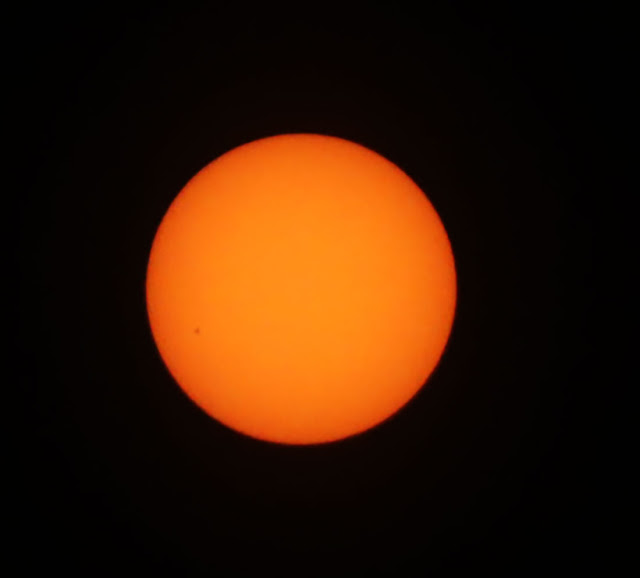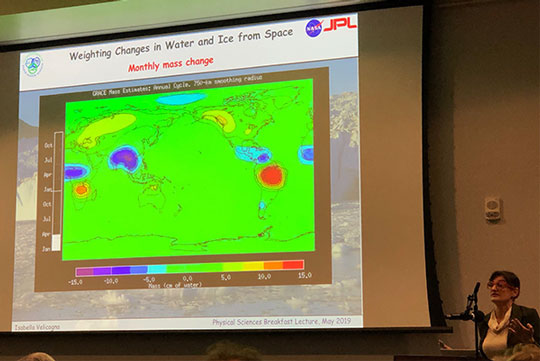Well, here we are and the weather is supposed to be pretty clear, so let's take advantage of that and head on up to the OCA star party and try out the lightweight Sky-Watcher mount and Coolpix P1000 camera.
So, even while we wait for sundown, we still have to look up in the sky. Here you can see some interesting contrails.
 |
| Interesting contrails in the sky as we wait for sundown at OCA Star Party (Source: Palmia Observatory) |
So this time around, in the darker skies in Silverado Canyon, we wanted to continue evaluating the Sky-Watcher mount by doing a more rigorous alignment than we had done in our first use of the mount. The image below shows Polaris, positioned so that the center of view of the camera frame should be pretty much aligned to the North Celestial Pole (NCP).
 |
| Trial positioning of Polaris in camera frame for North Celestial Pole (NCP) Alignment (Source: Palmia Observatory) |
The mount does not have a polar scope, but the mount app does have a polar scope view of the current position of Polaris, which is essentially about 1 degree away from the NCP. So, all I had to do here was move the mount so that Polaris was about 1 degree away from frame center. With the Coolpix P1000 set to about 1200mm focal length, the width of the frame covers about 2 degrees. The polar alignment scope app shows Polaris at that time of night to be at the upper right, but because there is no optical inversion on the camera viewfinder, the correct location of Polaris is as shown, at the lower left side of the image.
Ok, so let's just double check the position using astrometry and the image. The screenshot below shows the results after submitting the image to Astrometry.net. You can see that the center of frame is at 89 degrees, 59 minuets declination. Pretty close to right on the NCP. So, my eyeball guess is confirmed, Now this pretty good alignment does not mean that everything is going to come out ok, because the mount does not have a polar axis and their still could be some coning error between the camera line of side the elevation axis of the mount.
- The red dot finder was attached to the camera, but was not aligned to the camera axis. When I put the red dot right on the star, which I could see with my naked eye, the star was not in the camera view. So, the star I tried to align to was probably not the selected star. So, next time be sure to align the red dot finder first. It was too dark to use some distant object like a tree or notch in the mountains and I could have gone back to Polaris, but this is one time that I had wished the Moon was at least a little bit visible
- The Coolpix camera does not allow ISO > 100 when the lens is set to long focal lengths. So, to get a little more sensitivity for dim stars, one would have to go back to wide view telephoto. This was just not the direction I wanted to go. The P1000 reviews have said that the camera is not well suited for astrophotography. It was probably the case that since I could see the alignment star with my naked eyes, that I was just not on the right star.
The weather forecast for the rest of the week indicated that there was not going to be any more observing nights to check and refine the alignment process. We will just to postpone and try it out later.
 |
| No chance this week to try better Sky-Watcher mount alignment (Source: Palmia Observatory) |
The next day was again quite cloudy, but after hearing that a sunspot might be visible, as soon as there was just a momentary clearing in the skies, I went outside with a DSLR with 200mm telephoto lens and yep, sure enough, there is a visible sunspot.
 |
| Hey, we finally can see a sunspot on our "quiet" sun, DSLR 200mm (Source: Palmia Observatory |
So, I wanted to get a little better focus on the sunspot, but I had to run back inside to grab my hat so that I could shade my view of the camera Liveview screen and when I came back outside the clouds had closed ranks and the sun was hardly visible at all.
 |
| Oops, I'm not going to risk using this solar filter on my camera (Source: Palmia Observatory) |
Lesson learned: Things happen; filters break. So if you are planning on travelling thousands of miles to view an eclipse in Chile, or elsewhere, it might prove advantageous to bring along an extra filter. Just in case! So, I went immediately back to my friends at Amazon and clicked on the order to get a spare for every solar filter I was planning to use! And, no, I am not going to take a spare camera, but I probably will take a spare pair of eyeglasses! What kind of redundancy are you all planning for!
Ok, so the clouds are out, but there is still plenty to do for the aspiring astronomer or physicist wannabe. The UCI Physical Sciences Breakfast Series is a good place for a free breakfast and an interesting lecture. In this case, UCI Professor Isabella Velicogna explained how the satellite observatory, GRACE, which stands for Gravity Recovery and Climate Experiment, can measure very slight differences, while in orbit, of the Earth's gravitational field. This is done by a pair of satellites, whose separation in space is very accurately measured and this separation varies all so very slightly due to variation of the Earth's mass directly below the pair of satellites. For example, as the pair moves over a large land mass or mountain, the orbits and separation between the two satellites changes just slightly and this difference can be measured and correlated back to the mass on the Earth.
GRACE's orbit is sun-synchronous with an inclination of 89 degrees and period of about 94 minutes. So, orbit after orbit the GRACE eventually covers the whole Earth and can determine very tiny gravity deviations for the whole Earth.
 |
| UCI Professor Velicogna explains the GRACE mission concept at breakfast lecture series (Source: Palmia Observatory) |
Professor Velicogna and collaboration are able to use this gravity data to refine estimates of continental density and also track changes in ice and precipitation over the entire Earth. I selected a couple other slides, which sort of told the major story, and the slide below shows, just one instant from a short video, where the amount of rainfall, which does indeed change the mass over that location, and hence the gravity, falls and accumulates. Who knew that the mass of rain would be detectable in the gravity signal!
 | |
|
 |
| UCI Professor Velicogna explains how GRACE can track weight of ice and glaciers worldwide at breakfast lecture series (Source: Palmia Observatory) |
Another indoor activity for when the clouds get in your observing line of sight is to listen to the many podcasts on Sean Carroll's "Mindscape" at www.preposterousuniverse.com/podcast/. His weekly podcasts are hour long interviews with leading experts in many different fields and this week he discusses the world of the quantum, gravity, string theory and black hole information loss with Leonard Susskind. Now I have been studying Sean's "Spacetime and Gravity" and "The Big Picture" for several years now and listening to Leonard's dozens of YouTube physics lectures for many years now also. It is great just hearing these two physicists in a discussion of some of the current issues in physics. If you like this type of stuff, check out the other 44 podcast episodes now! I really enjoy them and you might too! Thanks for making them available, Sean!
One of the more interesting podcasts, not related to physics so much, as how we come to anything and how our current newscasts, like TV newscasts, have as their business model, the need to keep us all riled up and almost in warring camps so that we keep our eyeballs and attention glued to the TV. What we really need is help in recognizing our common goals and beliefs and working together to understand the issues and find common ground rather than being separated into warring camps. Check out Episode 35, with Jessica Yellin, former CNN broadcast executive, for all of the gory details. The people we have turned to in the past to help us find out what is going on, now have a vested financial interest in keeping us apart. Learning physics is hard, but so is coming to understand the issues that we currently face in our political divide and this podcast was a first part.
 |
| When the clouds come, listen to Leonard Susskind on Mindscape (Source: Sean Carroll, preposterousuniverse.com/podcast/) |
Until next time,
Resident Astronomer George
Be sure to check out over 300 other blog posts on similar topics
If you are interested in things astronomical or in astrophysics and cosmology
Check out this blog at www.palmiaobservatory.com


No comments:
Post a Comment